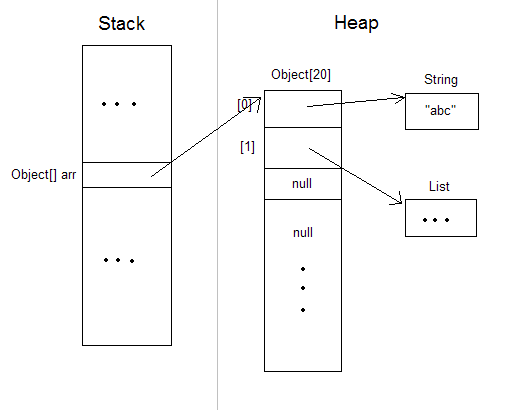Q1.What is the Difference between Stack and Heap?
Stack vs Heap
Q2.Does Wrapper Classes are immutable Similar to String?
Yes, Wrapper classes are immutable similar to String.
Q3.Does Wrapper Classes would be cached Similar to String Pool for Strings?
Yes.Java has Integer pool for small integers between -128 to 127 so it will behave same for Integer also similar to String Constant pool
java.lang.Boolean store two inbuilt instances TRUE and FALSE, and return their reference if new keyword is not used.
java.lang.Character has a cache for chars between unicodes 0 and 127 (ascii-7 / us-ascii).
java.lang.Long has a cache for long between -128 to +127.
java.lang.String has a whole new concept of string pool.
Q4.How String will behave in memory management incase of String Literal or String Object?
Q5.See the Below Code
class D {
public static void main(String args[]) {
Integer b1=127;
Integer b2=127;
Integer b3=128;
Integer b4=128;
System.out.println(b1==b2);
System.out.println(b3==b4);
}
}
true false
Why it is so?
If the value p being boxed is true, false, a byte, a char in the range \u0000 to \u007f, or an int or short number between -128 and 127, then let r1 and r2 be the results of any two boxing conversions of p. It is always the case that r1 == r2.
Q6.In which Memory would the following would be created?
int a = 0; Integer b = 0;
It Depends whether a and b variables are local variables or fields (static or instance) of an object.
If they are local variables:
a is on the stack.
b is on the stack (a reference) and it refers to an object in the heap.
If they are fields of an instance or class:
a is on the heap (as part of the instance or the class).
b is on the heap (as above) and it refers to an object in the heap.
Q7.Why the value of i didnt change after modify being called?
class Demo
{
public static void main(String[] args)
{
Integer i = new Integer(12);
System.out.println(i);
modify(i);
System.out.println(i);
}
private static void modify(Integer i)
{
i = i + 1;
}
}
Output
12 12 12 12
The reason again traces back to the Immutability of wrapper class.
i = i + 1;
It does the following:
- Unbox i to an int value
- Add 1 to that value
- Box the result into another Integer object
- Assign the resulting Integer to i (thus changing what object i references)
Since object references are passed by value, the action taken in the modified method does not change i that was used as an argument in the call to modify. Thus the main routine still prints 12 after the method returns.
Q8.How the array is stored in the memory?
arr[0] = new String("abc");
arr[1] = new List();
Stack has a single pointer to a location in the heap that contains the array itself. The array itself is just an array of pointers which also point to locations in the heap that contain the objects you reference.

Q9.What is Contagious memory block?
Array are “contiguous”. That means the elements are laid out end-to-end, with no discontinuities and no padding between them (there may be padding inside each element, but not between elements). So an array of 5 4-byte elements looks like this (1 underscore character per byte, the | symbols don’t represent memory).Arrays and ArrayList uses Contagious memory whereas LinkedList uses Non Contagious memory.
Contiguous
![]()
Non-Contiguous
![]()